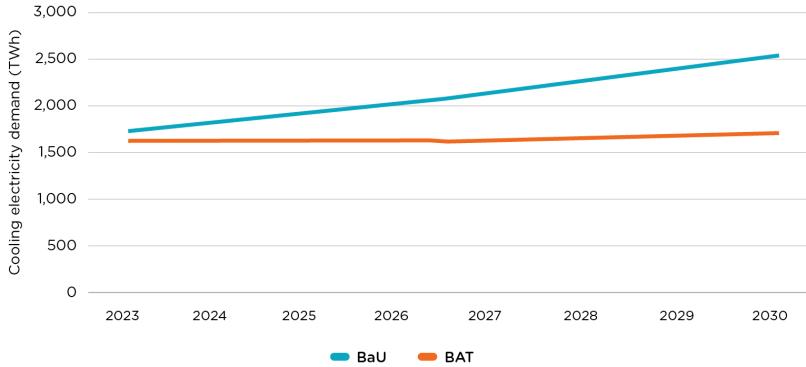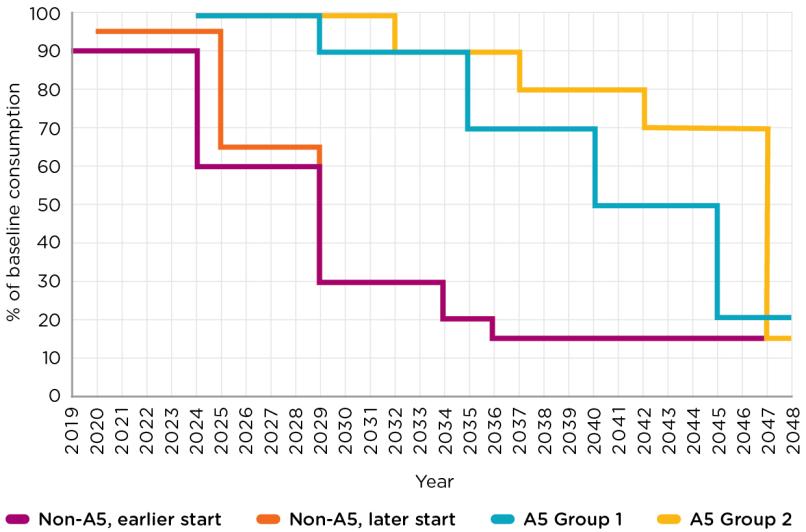The role of other goals and commitments on sustainable cooling
Achieving universal electricity access (SDG7.1.1) and eradicating extreme poverty (SDG1.1) by 2030 will be critical in reducing the number of people at high risk due to a lack of access to cooling. However, there is a need to further understand the role of SDG7.1 (including the quality of electricity access) and the role of SDG7.2 (substantially increasing the share of renewable energy by 2030), SDG7.3 (doubling of energy efficiency by 2030) and SDG13 (climate action) on access to cooling risks. All these factors are not currently factored into the gap analysis and will affect how cooling access needs are met and the impact that they will have on people, products and the planet.
The role of access to modern energy (SDG7.1)
Further analysis is needed to better understand the cooling solutions that can be made accessible to populations at risk, and their impact on reducing cooling access gaps. This analysis would build on the World Bank Multi-Tier Framework for understanding access to energy, where those with the lowest tier of access to energy will not have full access to sustainable cooling solutions. As people gain higher quality electricity access and increase their income levels, ownership rates of cooling solutions such as fans and refrigerators can be expected to increase. The affordability of efficient solutions that can be powered at lower tiers of energy access will therefore be important to bridging the cooling gap and accelerating uptake of sustainable cooling solutions. This is particularly important for off-grid consumers, with initial research from SEforALL and its partners pointing to the increasing viability of sustainable solutions at lower tiers of electricity access. [1]
The role of renewable energy (SDG7.2)
At present most cooling needs are met with active solutions (fans, air conditioners, refrigerators, cold storage, etc.) that require electricity to operate. Most electricity supply in developing countries is generated using fossil fuels and as such active cooling can be highly carbon intensive. However, increasing the renewable energy share in the grid and coupling cooling demand with renewable energy generation would have a major role in decarbonizing the cooling sector.
Unlike the space-heating sector, space cooling is not commonly centralized or serviced by district energy, and the lack of this scale of energy-service architecture creates barriers to leveraging large-scale variable renewable energy to power cooling demand. The potential of deploying renewable energy for sustainable-cooling access is immense, particularly for the rural poor living in off-grid settings. Electricity access delivered with decentralized renewables can support access to sustainable cooling as well as improve the livelihoods of farmers through productive uses of energy that include cooling. Achieving SDG7.2 by 2030 is therefore expected to play a key role in deploying sustainable solutions for different cooling needs and the impact of the effect of this on reducing cooling access gaps will be explored further in the future.
The role of energy efficiency (SDG7.3)
Energy efficiency is pivotal for the cooling sector to support climate and development goals. Cooling-appliance ownership is a major way to reduce risks faced by rural and urban populations, but low-efficiency standards for cooling appliances can contribute to energy-demand growth, increased emissions, and reduced household-purchasing power. Conversely, stronger energy-efficiency standards for cooling appliances can reduce cooling access risks by making operating costs affordable, reducing energy bills, and spreading available grid capacity to serve a wider section of the population. As such achieving SDG7.3 in the cooling sector is not only critical for climate action, but also for ensuring that the multiple benefits of energy efficiency enable the achievement of other SDGs.
With further analysis of energy efficiency there are two main interventions that would need to be assessed for their contribution to reducing access to cooling gaps – the impact of active and passive solutions. Energy-efficiency standards for active cooling coupled with passive solutions have the potential to drastically change the energy demand by 2030 and reduce carbon emissions.
The first energy-efficiency strategy should be to reduce the need for active solutions through the deployment of passive cooling. One example is by leveraging passive solutions for energy efficiency and thermal efficiency in the buildings, storage and vehicles where energy needs for active cooling can be reduced significantly. Also, passive strategies in built environments and farms, such as nature-based solutions, can provide the first level of heat stress relief through shade and natural cooling. These passive strategies lead to meaningful reductions in the UHIE, further reducing the need for active cooling and optimizing how and when energy-based active solutions are used. The need for this holistic approach and optimization with passive cooling will only become more important with rapid urbanization and growing heat islands that make all urban residents more vulnerable to the impacts of extreme heat.
Active solutions, such as energy-efficient air conditioners, fans and refrigerators, would need to be made affordable compared to inefficient alternatives through policies (e.g., minimum energy performance standards (MEPs) and labels) and market mechanisms to increase their supply, lower up-front costs and mainstream their adoption through addressing up-front-cost and information barriers. Air conditioners and fans already account for 20 percent of the total electricity demand in buildings globally and doubling their efficiency levels could reduce the energy demand in buildings for space cooling by 45 percent. [2]
Figure 1.22: Electricity demand for active cooling in high-impact countries under a business-as-usual scenario or with best available technology (2023–2030)
The role of sustainable cooling on climate action (SDG13)
Further analysis is needed based on scenarios for SDG7.2 and SDG7.3, in addition to the SDG7.1 and SDG1.1 scenarios, to understand the climate action (SDG13) implications of cooling needs in terms of the impacts on energy demand and the resulting carbon emissions. Closing cooling access gaps with sustainable cooling solutions is critical for the cooling sector to be in line with Paris Agreement goals. Further analysis can also support a better understanding on which populations are able to have reduced heat-related risks under different emissions pathways.
In a business-as-usual scenario, cooling demand from mechanical solutions such as air-conditioning and refrigeration alone is expected to result in 12 GtCO2eq by 2050, which would be equivalent to one-third of global carbon emissions in 2017. [3] The year 2030 is an important milestone for climate action, since the pathway to achieving the Paris Agreement requires achieving a 45 percent emissions reduction by 2030. [4] To ensure efforts to deliver access to cooling are consistent with the SDGs and the Paris Agreement, efforts must also align with this emissions reduction target.
The role of achieving the Montreal Protocol
The Montreal Protocol is an international treaty designed to protect the ozone layer, and the Kigali Amendment pushes one step further to reduce the impact from hydrofluorocarbons (HFCs).
Refrigerants are considered the blood of refrigeration and air-conditioning systems. However, synthetic refrigerants, historically mainly chlorofluorocarbons (CFCs), hydrochlorofluorocarbons (HCFCs) and HFCs have had significant impacts on ozone and climate. The Kigali Amendment also promotes energy-efficiency opportunities (supporting SDG7.3) that can be leveraged with the climate-friendly refrigerant transition and is estimated to have the potential to avoid a temperature rise of up to 0.4°C by 2100. [5]
Figure 1.23: Kigali Amendment HFC phase-down schedules
Climate-friendly refrigerant transitions are happening on different timelines for developed and developing countries, given their differing economic status and market readiness levels to adopt new technologies. Developed countries, for example, are only expected to freeze their HFC consumption level from 2024, with the first phase-down step expected in 2029 and the final phasedown completed by 2047. Given the implementation schedule of the climate-friendly refrigerant transition, it will be important to consider the impact of the Kigali Amendment on the availability and affordability of sustainable cooling solutions for vulnerable groups, along with universal electricity access, renewable energy and energy efficiency.




